Text

optimization and hyperbolic functions
We're down to the last topics for this school year! Math 5 is a roller coaster ride, isn't it? For this post, we will be solving problems involving optimization, which is an application of derivatives, and hyperbolic functions!
Optimization (Learning guide 6)
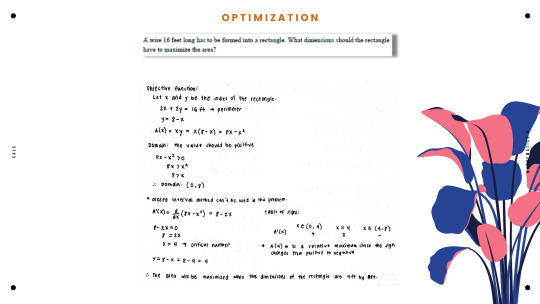
Optimization problems involve finding the maximized or minimized value of a particular quantity. In the example above, we are asked to solve for the dimensions of the rectangle given the length of a wire that will maximize the area. The steps in solving optimization problems are: First, find the objective function. Second, find the domain of the function. Third, choose the best method to proceed, either closed interval method, FDT, or SDT. And lastly, solve for the value.

Hyperbolic Functions (Learning guide 7)



Hyperbolic functions are functions that are defined in terms of exponential functions. In solving problems that involve hyperbolic functions, we can use hyperbolic identities as well as the basic concepts of differentiation.

Reflection (Weeks 6 and 7)

I think one of my strengths during these weeks is that I became more productive than the previous weeks. I finished the requirements way ahead of time. Because of this, I'd have more time to do requirements in my other subjects. Moreover, I think I have understood the topics pretty well. Although I had a hard time understanding the optimization problems, I became more familiar with the topic as I answered the problems in the learning guide. Practice is truly the key to understanding difficult math concepts.
Math 5 is indeed a roller coaster ride. Low scores in quizzes, concepts that are difficult to understand, lack of motivation - this journey was a very bumpy ride. Despite this, I think all my efforts in this subject had been paid off based on the knowledge that I was able to gain and the scores that I received. Although learning math is truly challenging in this setup, still, I was able to learn crucial concepts that I will always remember (WOW haha)
I thank our Math teacher, Sir Ric, for being so kind and considerate. I would not survive this subject without his lectures and supplementary videos <3.
I would continue my good habits in the next school year so that I'd be able to perform well just like my academic performance this school year.
Thank you! <3
-m.y.
#math#mathematics#derivatives#calculus#differential calculus#optimization#applications of derivatives#hyperbolic#function#hyperbolic function#mathcore
0 notes
Text

applications of derivatives
Hello! Welcome back to this blog. For this entry, I will be showing my solutions to problems regarding the applications of derivatives, particularly the rates of change, rectilinear motion, and related rates.

As seen in the example above, derivatives could be used in solving problems involving rectilinear motion. In the example, we are tasked to find the time at given the velocity and acceleration.


The examples presented above are examples of derivative applications on problems involving rates of change.

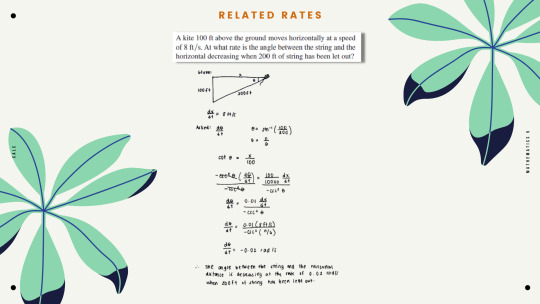
The examples above are examples of problems on related rates. In a related rates problem, the idea is to compute the rate of change of one quantity in terms of the rate of change of another quantity. Implicit differentiation could be used in these problems.

Reflection (Weeks 4 and 5)

Our topics for these weeks were so hard and challenging to understand. I had a hard time understanding the topic :( I even took the quiz even though some points were not clear to me. Luckily, I was able to get a good score on the quiz. The supplementary videos provided by our teachers were really helpful for the assessment. (I am extremely grateful for that <3) I think I was more productive during the third week than the fourth and fifth week based on how early I started learning the modules. I'd try my best to be more productive in the next weeks since we also have tons of requirements in other subjects. I am hoping that I'd be able to overcome the number of requirements we have this fourth quarter.
-m.y.
#math#mathematics#differential calculus#derivatives#calculus#functions#related rates#rectilinear motion#rates of change#mathishard
1 note
·
View note
Text

sketching graphs
Hi!! Welcome back! In this post, we will be discussing a topic that will basically sum up what we discussed in the last posts. Sketching graphs of function encompasses the topics we discussed last time like the extrema of functions and the first and second derivative tests. Let's see below the steps in sketching graphs of functions.
1. Find the first derivative 𝑓′ and determine the intervals at which the function is increasing or decreasing and the local extrema values via the first derivative test. Summarize the information using a table of signs.
2. Find the second derivative 𝑓′′ and determine the intervals at which the function is concave up or concave down via the second derivative test.
3. Consider other additional information about the function, e.g., asymptotes, if any.
4. Graph the function 𝑓 by utilizing the information obtained.
Using the steps below, let's solve the problems below:



As we can see above, the first derivative test was first used to find the extrema values. The second derivative test was then used to find the concavity per interval and the points of inflection.

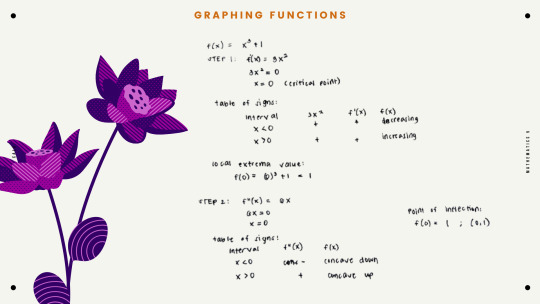

The same steps were done in the example above.

Reflection (Week 3)

I think I made improvements this week in terms of my productivity. I learned how the concept of derivatives is being used in graphing functions which is so awesome! Although I'm not really into graphing because the process is quite tedious, I always found it satisfying every time my graph is correct. Since this topic is covered in the quiz and long test, I will try to love graphing as much as possible :))). I hope I will do good in the long test!!
-m.y.
1 note
·
View note
Text

First Derivative Test
Second Derivative Test
Hi! We are back with another topic. We will be discussing the applications of derivatives, mainly in identifying critical numbers of a function. Let's see how the First Derivative Test (FDT) and Second Derivative Test (SDT) are used in the examples below.


In the example above, we are tasked first to find the first derivative of the function. After finding the first derivative, we equate the equation to 0 to find the critical numbers. After which, we will be making a table of signs (as seen on the second photo). This is to predict the behavior of the graph on the intervals. If the f'(x) turned out to be positive, the graph is increasing on the interval, while if it is negative, the graph is decreasing on the interval.

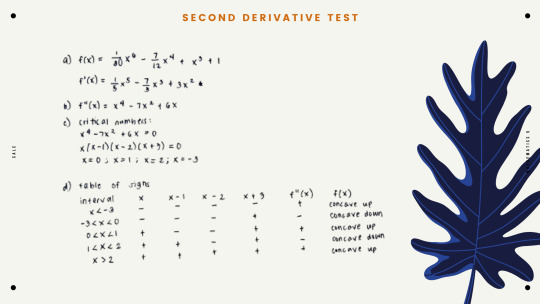
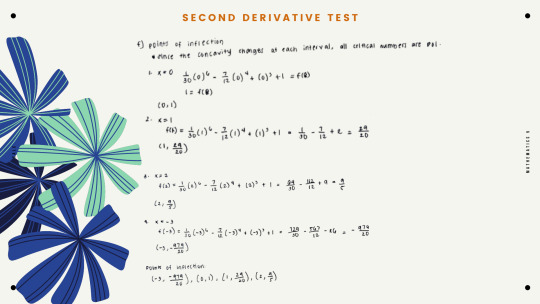
In the example above, we used the Second Derivative Test to find the concavity of the function at the given intervals as well as the points of inflection. After finding the first derivative, we are to solve for the second derivative to find the critical numbers. After finding the critical numbers, we will also be making a table of signs just like in the previous example. If f''(x) is positive, the graph concaves upward, but if f''(x) is negative, the graph concaves downward. Moreover, we concluded that at each critical number, there is a point of inflection since the concavity of the graph changes at each interval. We find the y-values of the points of inflection by plugging in the critical numbers into the original function.

Reflection (Week 2)

I am glad that I have understood what the First Derivative Test and the Second Derivative Test were. I was kind of confused at first especially with the table of signs, but when I consulted supplementary materials and videos, I was able to understand how it works. I think it is truly important to consult other references whenever I am having a hard time understanding a topic. Generally, I think I did well this week. I took the quizzes early and was satisfied with my scores. I will try my best to maintain this habit until the end of the quarter.
#derivatives#calculus#mathematics#math#differential calculus#derivative#fdt#sdt#first derivative#second derivative#im tired
1 note
·
View note
Text

EXTREMA OF FUNCTIONS
Hi! It's been a month since my last post. We are down to the last quarter of this school year!! For this week, we will be discussing Extrema of Functions. Let's check the examples below:
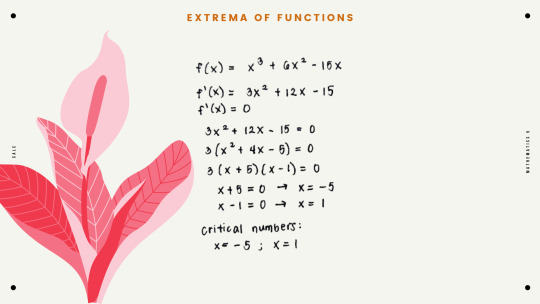

For the examples above, we are tasked to find the critical numbers for each function. The definition of critical number is: a number c in the domain of f such that either f'(c)=0 or f'(c) does not exist. This is why the first derivative of the functions above were equated to 0 to find the critical numbers. We also need to make sure that the numbers solved are in the domain of f to consider them as the critical numbers of the function.


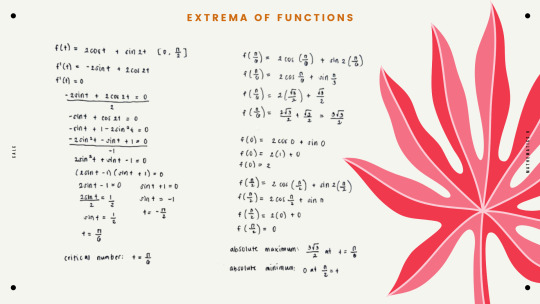
In the examples above, we are tasked to find the absolute maximum and the absolute minimum values of f in the given intervals. First, we need to find the critical numbers of the functions. Then we will use the Closed Interval Method to find the absolute minimum and maximum values. This is done by finding the value of f at the critical number(s) and at the endpoints of the interval. The largest value is the absolute maximum while the smallest value is the absolute minimum.

Reflection (Week 1)

My mind still can't process that we are now at the last quarter of the school year. I think this is why during this week, I did not do much in this subject. I did not study the learning guides right away. I just started after the synchronous class, where we discussed the topic. I think this has been my habit since the second quarter which needs to be improved. I need to be more productive in the following weeks so that I won't have many backlogs, especially since our long test is scheduled next week. I also watched the supplementary videos which made my understanding of the topic better. I will my best to devote enough time for this subject. <3
1 note
·
View note
Photo

HIGHER ORDER DERIVATIVES
Learning guide 5.8
Welcome back! So this will be the last post for this quarter! In this post, we will be discussing Higher Order derivatives. This is an interesting topic because finally we get to see how second order derivatives, third order derivatives, etc are solved. Let’s check the examples below:


What is interesting about this topic is that the process is simple and satisfying. We are tasked to find the second order derivatives of both functions given. To solve for the second order derivatives, what we just need to do is to get the first derivative of the function and get the derivative of that first derivative. Voila! It’s that simple isn’t it? Well of course, we need to recall the previous rules and derivatives to solve for the higher order derivatives of functions accurately.

Reflection (Week 7)

As I have said, the topic for this week is so interesting! With that, I was able to understand the topic very easily. I was also able to finish the quiz before the deadline, this is a habit that I have maintained from the previous weeks. I am glad that I became productive this week despite the hectic schedule and the amount of requirements in other subjects. Our second long test is next week! I am already nervous about it but I am confident that I’ll do my best in the exam. Just like in the gif above, it’s gonna be great!
-m.y.
0 notes
Photo

CHAIN RULE
IMPLICIT DIFFERENTIATION
Learning guide 5.6 and 5.7
Well for this week, we new topics to deal with. We will be discussing the Chain rule and Implicit differentiation in this post. At first, understanding these topics will be quite challenging but once we get the gist, we are good.
Learning guide 5.6 (Chain rule)
Chain rule is used when we are finding derivatives of composite functions. This rule tells us how to differentiate composite functions like f(g(x)). Let’s check the example below:
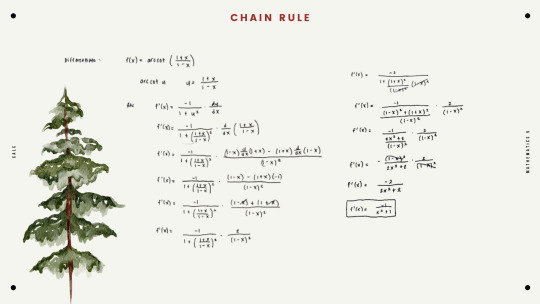
In the example, we can express f(x) as g(h(x)) where arccot is the outer function g(x) while (1+x/1-x) is the inner function h(x). Since it is a composite function, we can use chain rule to differentiate the function. We will also be using other rules like the quotient rule to get the derivative of the whole function.

Learning guide 5.7 (Implicit Differentiation)
In implicit differentiation, we differentiate functions that contain two variables (usually x and y). We are differentiating both sides of the function just like in the example below.
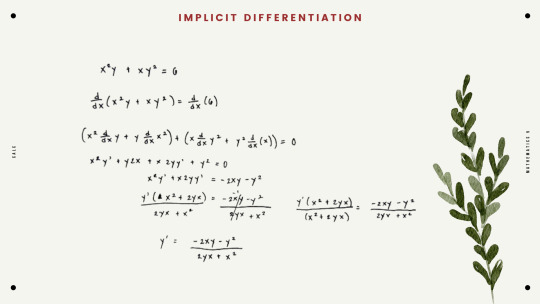
Implicit differentiation is just like finding the value of x, except in this kind of differentiation, the variable y’ which is the derivative, is being solved for. Other rules such as the power rule and product rule are also used in the example.

Reflection (Week 6)

Blair (in the gif above) is such a mood each time I wake up in the morning. To be honest, I am lacking motivation. Despite this, I’d say that I became more productive this week in math than last week. I finished the modules on time and I got a good score in the quiz! After the quiz I felt like I needed more practice to fully master the topic so I watched supplementary videos as well as solved practice items. This helped me master the topic. I will maintain this habit in the following weeks especially if the topic is really confusing.
0 notes
Photo

DERIVATIVES OF TRANSCENDENTAL FUNCTIONS
Learning guide 5.5
Hello! Welcome back to this blog after weeks of hiatus. I have been very busy but I did not forget about this at all. In fact, we have another learning guide to discuss today. In this post, we are going to deal with the Derivatives of Transcendental functions, which include the derivatives of exponential, logarithmic, and trigonometric functions.
Learning guide 5.5.2
Transcendental function is defined as any function that is not expressible as a combination of several algebraic operations. Exponential, Logarithmic, and Trigonometric functions are all transcendental. There is a special way on how to find the derivatives of this kind of function. Let us explore the examples below.

In this example, we have a function expressed as a quotient. With this, we are going to use the quotient rule to find the derivative of the function. Moreover, since the numerator is also expressed as a product, we will also be using the product rule for this. The derivative of sin x, which is a transcendental function, is cos x.

In this example, we have an inverse trigonometric function given by arctan x. We know from the learning guide that the derivative of arctan x is 1/1+x^2. We will be using this to find the derivative of the whole function. The sum rule and product rule will also be used to find the derivative of the function.

Reflection (Week 5)

When this week started, I really did not prioritize this subject since we did not have any requirements at the time aside from the modules. However, I felt like my backlogs in this subject were piling up. With this, I had to move so that I won’t be drowning in requirements. I have realized that I need to be motivated more so that I would be more productive. I am glad that I was able to get back on track. I hope that I will be able to improve in the following weeks. I am ready to conquer what’s coming in the following weeks like Hawk in Cobra Kai (although I really hate his character), in the gif above.
-m.y.
P.S. While making this blog post, I was watching Cobra Kai, a really good show about karate! You should check it out!
0 notes
Photo

RULES ON DIFFERENTIATION
Learning guide 5.4
Hello! So we’re back again with another blog entry! For this entry, we will be discussing the rules on differentiation. Although this term seems unfamiliar, it’s basically finding derivatives of functions using different rules: power rule, sum rule, difference rule, product rule, and quotient rule.
Learning guide 5.4.1 (Product rule, Sum rule, Difference Rule)
If we have quadratic functions, we should use the power rule, sum rule, and the to use to find their derivatives. By using these rules, we don’t have to use the limit definition we learned last entry! Let’s check the examples below.


See how easy it is to solve for the derivatives using these rules! Also, since the derivative is the equation for the slope of the tangent line, we can also use these rules to find the slope just like in the second example.
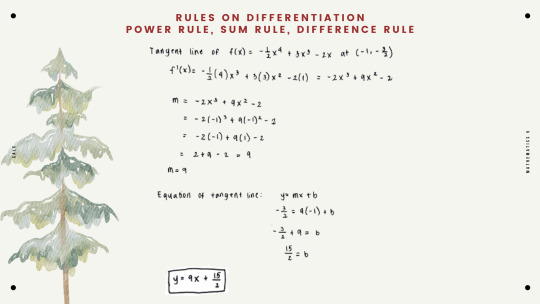
In the given example above, we are tasked to solve for the tangent line equation by solving for the derivative. We used the rules to solve for the slope and used y=mx+b to find the equation. It’s quite easy right?

Learning guide 5.4.2 (Product rule)
Let’s move on to the product rule which is quite tricky. In product rule, we are not just multiplying the derivatives of the functions to be multiplied. Let’s check what the product rule is, in the examples below.


We can find the derivatives of such functions by using the product rule. See, it’s not just multiplying the individual derivatives. The product rule states that if f(x) and g(x) are both differentiable, then their product would be equal to f(x) * g’(x) + g(x) * f’(x).

Learning guide 5.4.3 (Quotient rule)
For me, the quotient rule is the most complicated rule. Just like the product rule, quotient rule is not just dividing the derivatives of the individual functions. It’s more tricky than that. Let’s see the examples below.


We can use the other prime notation: lo(d/dx hi) - hi (d/dx lo) / lo*lo, where hi is the numerator and lo is the denominator. We can also use the quotient rule in finding the slope of the tangent line of radical functions just like in the second example.

Reflection (Week 3)

It took me a longer time to finish the learning guides for this week since there were three of them. Despite this, I am glad that I was able to fully understand the topic. When I was answering the exercises in the LGs, I was so happy and satisfied whenever I got the correct answers! I was able to somehow enjoy learning this topic. The videos Sir Ric made regarding this topic were also helpful as reinforcements. The week was truly exhausting but it deserves to be danced out because of the small accomplishments I had throughout the week!
-m.y.
P.S. Dancing out episodes in Grey’s Anatomy really hit different <3.
#math#mathematics#calculus#differential calculus#differentiation#derivatives#grey's anatomy#dance it out
0 notes
Photo

TANGENT LINE
DERIVATIVE OF A FUNCTION
Learning guide 5.1
Hiii! It’s me again, bringing more math concepts to you! So, for this entry, we are going to discuss tangent lines and derivatives of a function. This is an important lesson that we need to fully understand because the derivative is the heart of calculus! Let’s do this!
Learning guide 5.1.1 (Tangent Lines)
Well we all know what a tangent line is: a line that touches the graph of the function at a specific point. For this topic, we need to recall the concept of linear equations introduced in grade 8! Let us check how to find equations of tangent lines using the example below:

The solution is a bit overwhelming but let’s start with the slope of tangent lines. We can employ the concept of limits to find the slope. Given the limit definition presented above, we just need to plug the x value into the equation to find the slope. After finding the slope, we can use the linear function y=mx+b, to get the equation of the tangent line. That’s it, that is how you find the equation of the tangent line. BUT wait, there’s more! In the given problem, we are also required to solve for the normal line equation. Normal line is the line perpendicular to the tangent line, thus the slope of a normal line is the negative reciprocal of the slope of the tangent line. With that, we can proceed to solve for the equation using y=mx+b. :))

Learning guide 5.1.2 (Derivative of a function)
For this learning guide, the concept of derivatives is introduced. The topic is quite intimidating, right? But, as long as we get the gist and understand the process of finding the derivative, we can do this! So what are derivatives in the first place? It is the rate of change of a function with respect to a variable. Let’s study the examples below to further understand the topic.


We used the limit definition of derivatives to find the derivative of the functions. The formula seems familiar right? Well, it it just the formula for the slope of tangent line. The concept of limits is used for the both topics. In the first example, the derivative notation used is dy/dx. There are a lot of other notations that can be used like f’(x), y’, d/dx, among others.

Reflection (Week 2)

I think I was able to maintain my good habits I have started last week. I must say that studying the learning guides for this week was quite fun and interesting because I was able to understand the topic very easily. I am confident that my efforts have been paid off in the quiz. I will maintain my good habits in the coming weeks! <3
-m.y.
P.S. Cristina Yang issa mood this week!! (see the gif above!)
#math#derivatives#mathematics#differential calculus#calculus#tangent line#tangent#cristina yang#grey's anatomy
0 notes
Photo

TYPES OF DISCONTINUITY
CONTINUITY ON AN INTERVAL
Learning guides 4.2 and 4.3
Hi, it’s me again!! Let’s start this quarter by learning about the types of discontinuity and continuity on an interval. It will be a challenging topic but with the help of the exercises that we will be solving, it will be a piece of cake! Let’s start!!
Learning guide 4.2 (Types of Discontinuity)
In this learning guide, the types of discontinuity were introduced namely: Removable Discontinuity, Jump Essential Discontinuity, and Infinite Essential Discontinuity. The functions below have jump essential discontinuity on the given value of x. Let’s investigate how to check if a function has a discontinuity.

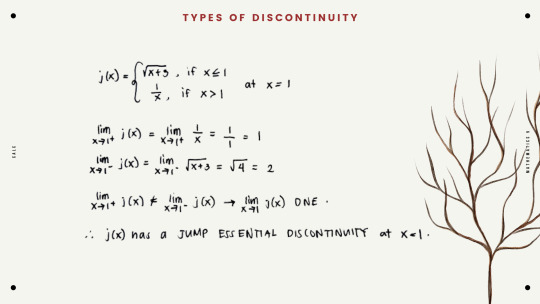
To check a function is discontinuous, we will be employing the rules we learned on the concept of continuity. A function is discontinuous if it does not satisfy the three conditions: the limit exists, the f(c) is defined, and f(c) is equal to the limit. The examples above are examples of functions which have jump essential discontinuities at the given value of x. We can see that the limits of the functions do not exist using the concept of one-sided limits.

Learning guide 4.3 (Continuity on an Interval)
In this learning guide, the concept of continuities on intervals is introduced. Let’s check the example below and learn how to check continuities on given intervals.

Since the function above is a piecewise function, we are to evaluate the its continuity on the intervals given. We learned that a function is continuous on intervals that are part of the domain of the function. At x=1, since the function is polynomial, we can say that it is continuous at that point. Investigating its continuity at x=3, we can conclude that it is also continuous at that point since the limit exists and h(3) is equal to the limit. With that, we can conclude that the function is continuous at the interval [1,6).

Reflection (Week 1)

To be honest, I was kind of lax at the beginning of the week since the quarter just started. But since my goal for this quarter is to have a higher grade, I started studying the learning guides for this week before we have our synchronous class. At first, I did not understand the topic quite well. I was so confused when I reached the learning guide 4.3, however, as we discussed it during our synch session, my understanding of the topic became wider. Discussions during synch classes really help! I think my study habits for this quarter would just be the same as last quarter. I would keep this up so that I could attain my goal at the end of the quarter!
-m.y.
P.S. I made this blog entry while listening to Lo-fi music from ChilledCow, you should check it out too!
0 notes
Photo

LIMITS OF TRIGONOMETRIC FUNCTIONS
CONTINUITY OF A FUNCTION AT A NUMBER
Learning guides 3.8 and 4.1
Hello! Welcome back to the blog. For this entry, we will be discussing the limits of trigonometric functions and continuity of a function. Sit tight for this one since we need to recall trigonometric functions which were discussed in grade 10! To enhance our skills regarding these topics, we will be answering some exercises involving them.
Learning guide 3.8.1 (Limits of Trigonometric Functions)
In this learning guide, limits of trigonometric functions are introduced. There are two theorems discussed in this module. First, if c is an element of the domain of f(x) which is a trigonometric function, the limit of f(x) as x approaches c, would be f(c). The other theorem involves composition of trigonometric functions. These theorems would be helpful in solving the limits of trigonometric functions.
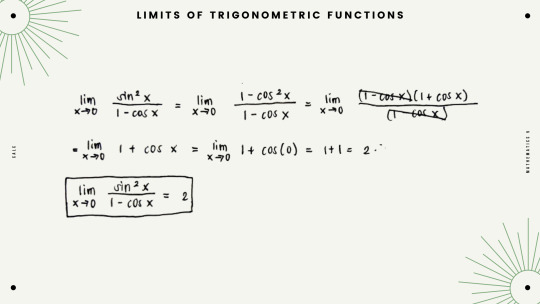
For this example, we are looking for the limit of the trigonometric function sin^2 x/1 - cos x as x approaches 0. Since sin^2 x can also be written as 1 - cos^2 x (pythagorean identities). Expanding 1-cos^2 x will give us (1 - cos x) (1 + cos x), and since 1 - cos x is also in the denominator, it will be cancelled out, leaving us with (1 + cos x). Since cos 0 is 1, the limit of the function would be 2.
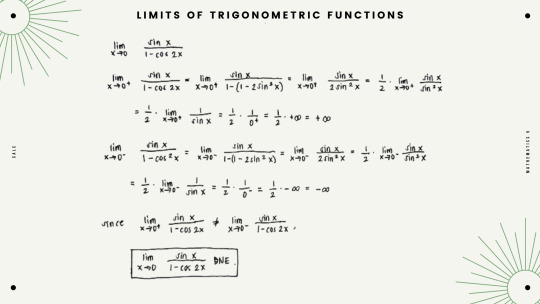
In this exercise, we will be using the concept of one-sided limits again. In the function, we can write cos 2x as (1-2sin^2 x). We can factor out 1/2 from sin x/2sin^2 x. From there we will get sin x / sin^2 x which will give us 1/sin x. This term would infinity since the denominator would be 0. The steps are basically the same with both 0+ and 0-, except we will get +∞ and -∞ respectively. Since the limits from both sides are not the same, the limit of the trigonometric function does not exist.

Learning guide 3.8.2 (Limits of Trigonometric Functions)
In this learning guide, new theorems on the limits of trigonometric functions are discussed. These theorems will help us in solving the limits of trigonometric functions when substitution will give us indeterminate forms.

In this example, first, we multiplied the conjugate of the numerator to both numerator and denominator to get 1-cos^2 x, which is also equal to sin^2 x. Factoring out the terms will give us sin^2 x/ x^2 and 1/1+cos x. We can expand sin^2 x/x^2 to (sinx/x)(sinx/x) which are both equal to 1 by Theorem 1. This will leave us with 1/1+cos x. Substituting 0 to cos x, will give us cos 0 which is equal to 1. Thus, the limit of the function as x approaches 0 is 1/2.

Learning guide 4.1 (Continuity of a function at a number)
In this learning guide, we are introduced to the concept of continuity. We know that a graph or a function is continuous when there are no breaks in the graph. We can check if a function is continuous at a certain point if it satisfies the given three conditions in the learning guide. Let’s check if the item below is continuous or not at the given number.
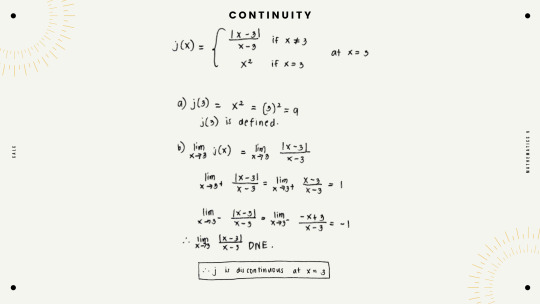
To check if the function is continuous at x=3, we need to evaluate if it satisfies the conditions. First, if j(3) is defined. Since the function has a value when 3 is substituted to x, we can say that it is defined. Let’s check if it also satisfies the next condition which is the limit of the function as x approaches 3 exists. To evaluate the limit, we will be using the function with the absolute value. We will be using the concept of one-sided limits for this. Since the individual limits are not equal, the limit of the whole function as x approaches 3, does not exist. Since it does not satisfy all three conditions, we can conclude that the function is discontinuous at x = 3.

Reflection (Week 4 and 5)

For this week, I can say that I am more productive unlike last week. I focused on studying these learning guides since the long test is fast approaching. Working on the exercises in the learning guides really helped me understood the topic better. Even though some parts are hard, I had fun learning the topic. It has also challenged me in some ways since I had to recall topics which were discussed in previous grade levels. I will maintain my good habits this week so that I would also be productive in the weeks to come.
-m.y.
0 notes
Photo

LIMITS OF EXPONENTIAL AND LOGARITHMIC FUNCTIONS
SQUEEZE THEOREM
Learning guides 3.6 and 3.7
Hi! Welcome back to the blog. I’m sorry for not uploading during the holiday season but starting this week, I’ll be writing new blog entries! For this week, we will be discussing the limits of exponential and logarithmic functions as well as the squeeze theorem. We will also be solving exercises regarding it.
Learning guide 3.6.1 (Limits of Exponential Functions)
In this learning guide, the concept of limits of exponential functions is introduced. For this topic, we need to recall the meaning of exponential functions. There are four theorems introduced in this learning guide that are helpful in solving the limits of such functions.

In this first example, we are finding the limit of e^-1/x as x approaches 0 from the right side. Here, since the exponent is negative, we will make it positive by putting the base e in the denominator. Since 1/x approaches +∞, the function will also approach +∞. By the theorem 2, the answer would be 0, since 1/e is greater than 0 but less than 1.
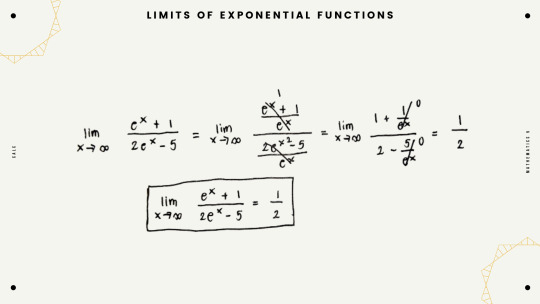
In this example, we will be dividing the the numerator and denominator by the highest power in the denominator which is e^x. This is because as x approaches infinity, the limit of each exponential function would also be infinity if the base is greater than 1. In this case, e is greater than 1. The limit would result to 1/2.

Learning guide 3.6.2 (Limits of Logarithmic Functions)
In this learning guide, the limits of logarithmic functions (log) is discussed. We also need to recall the definition of Logarithmic functions to understand how to compute for their limits. There are also four theorems discussed in this learning guide that will help us solve for the limits of said functions.

In this example, we are looking for the limit of x/ln x as x approaches 1 from the left. First, we need to separate the two terms to make it easier. Since the limit of x is a when x approaches a, the limit of x would be 1. For the other term, it would be 1/0- since x is approaching 1 from the left, x < 1, thus ln x would be negative. Since 1/0- is -∞, the limit of the function would also be -∞.

Learning guide 3.7 (Squeeze Theorem)
Although quite complex, this theorem is one of the most essential theorems in calculus which is particularly helpful in evaluating limits where other techniques might be complicated. To understand the theorem more, you may use this reference: https://www.youtube.com/watch?v=lVIb9iJ-rRI&t=219s

For this example, we will start of with the cos 2pi/x. Since the range of the graph of the cosine function is [-1,1], the two values will be the upper and lower limit of the equation. We will be making the values for all sides exponents of e. The square root of x will be multiplied to all sides to get the function. By the Squeeze Theorem, if the limit of f(x) = h(x) = L, then limit of g(x) = L. Since the limits of the sides are both 0, the limit of the function would also be 0.

Reflection (Week 3)

I could say that I am not that productive this week since I did not start learning the modules on time. There were a lot of requirements in other subjects that is why I was not able to focus on math learning guides. Since I ended up not being productive, I will study the learning guides on schedule in the following weeks to be productive again.
At first, I had a hard time learning Squeeze Theorem. Watching the lecture video of Sir Ric, together with other supplementary videos about it online, I was able to understand the theorem very well. I have realized that in order to understand a topic better, studying and watching supplementary videos and lectures would be a big help.
-m.y.
P.S. Listening to Lo-fi music while studying is helpful in maintaining focus. This playlist: https://www.youtube.com/watch?v=E__441h1D2k may help you also. :))
0 notes
Photo

ONE-SIDED LIMITS
INFINITE LIMITS
LIMITS AT INFINITY
Learning guides 3.3, 3.4, 3.5
Welcome back to this blog! For this week, we will be talking about One-sided limits, Infinite limits, and Limits at Infinity. We will be solving exercises regarding the said topics.
Learning guide 3.3.1 (One-sided Limits)
In this learning guide, the concept of one-sided limits which was introduced in the first quarter, was explained in a deeper and more complex level. Here we are going to evaluate the specified limits which involve piecewise functions.

(a) In the first example, we are looking for the limit of the function as x approaches -3 from the right. Since we are looking for the limit from the right, we will be using the function when x is greater than or equal to -3, which is 2x-1. From there, we can plug-in -3 to the equation to get -7.
(b) In this example, we are evaluating the limit of the function as x approaches 0 from the left. Since we are looking for the limit from the left, we will be using the function when x is less than or equal to 0, which is 2x^3 - 5. Plugging in 0 to the equation will give us -5 as the limit.

Learning guide 3.3.2 (One-sided Limits)
For this learning guide, the concept of one-sided limits in absolute value functions and greatest integer function were discussed. In the following examples, we are going to evaluate the limits of such functions.

Absolute value functions are involved here in this example. As we are looking for the limit of the piecewise function as x approaches 3, we need to evaluate the limits from both sides (left and right). From the right, we will be using the equation with the absolute value. For this, we need to recall the definition of absolute value functions and apply it. The limit of the function from the right is 4. On the other hand, we will be using 3x-5 in evaluating the limit from the left since the condition is x < 3. Since the limits from both sides are the same, the limit of the piecewise function is 4 as well.
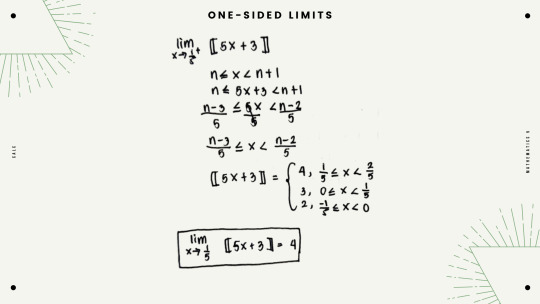
In this example, the greatest integer function is involved (denoted by the bracket). We need to recall the definition of the said function so that we can evaluate its limit. Evaluating the inequality will give us the piecewise function above. Since we are finding the limit of the function as x approaches 1/5 from the right, the answer would be 4.

Learning guide 3.4.2 (Infinite Limits)
Can the limit of a function be infinity? Yes, there are infinite limits. In this learning guide, the concept of infinite limits was tackled and how the graph of functions which have infinite limits behave. In the example below, we will be making a conclusion on how the graph behaves.

In this example, we are tasked to make a conclusion on how the graph of the function behaves in the cartesian plane. Using the concept of one-sided limits, we need to evaluate the limits of the functions as x approaches 1 from both sides (left and right). When x approaches 1 from the right, we will get +∞. When x approaches 1 from the left, on the other hand, we will get -∞. With this, we can conclude that the graph of the function will increase without bound from the right and will decrease without bound from the left as x approaches 1.

Learning guide 3.5.2
In the learning guide 3.4, the concept of infinite limits was discussed. However, how about limits of a function as x approaches infinity? In the following examples, we will be evaluating the limits of the functions as x approaches infinity.

In this example, we are dealing with rational functions whose denominator and numerator are infinities. We will be evaluating this by first, dividing the numerator and denominator by the highest power of x found in the denominator. In this example, the highest power of x is x^3/2. By the Theorem 3 (the limit of a rational function would be 0 if the limit of the numerator is constant and the limit of the denominator is infinity) in Learning guide 5.2, some terms will be equal to 0, leaving us with -1/2 as the limit.

In this example, we factored out the radical to have a rational function. By applying limit theorems, we can find the limit by multiplying the individual limits of each term. The first term involving the radical, will be equal to positive infinity. While in the second term, some terms will be cancelled, leaving us with 1/2. As the limit of the function is the product of each individual limits, the limit of the function would be the product of the infinity and 1/2, which is equal to + ∞.

Reflection (Week 2)

I did not expect to finish all the learning guides a week before our Long test. I don’t know what came to my mind lol but, I am proud of this achievement. I was also able to finish this blog entry on time!! I am joyful with these small achievements. I would say that I am productive (in math) this week and, I think that is great considering the number of learning guides in all of our subjects. I have realized that focus is crucial to finish what is needed to do.
-m.y.
P.S. I was listening to this Spotify playlist while studying the LGs and while making this blog entry, you might want to check it out! https://open.spotify.com/playlist/37i9dQZF1DWWEcRhUVtL8n?si=-YZqijpZRIyKqk2nPG4NOQ
2 notes
·
View notes
Photo

DEFINITION OF LIMITS
LIMIT THEOREMS
Learning guides 3.1 and 3.2
Hello! Welcome back to this blog! For this week, we have already started with the lessons in second quarter. This means that we will face much complex topics than before. I am here to help you understand some problems regarding the topics Definition of Limits and Limit theorems. So, let’s begin!

Learning guide 3.1.2 (Definition of Limits)
In this learning guide, both the intuitive and formal definitions of limits were introduced and as an exercise, we will be proving the limits below if they are true based on the formal definition of limits.
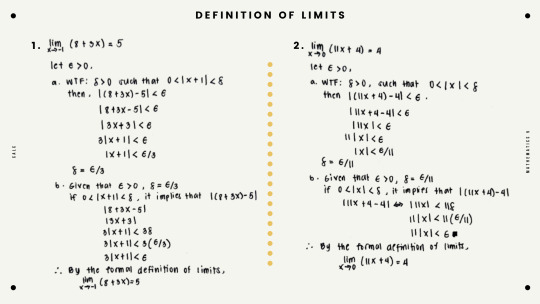
We were able to prove the given limits based on the formal definition of limits.

Learning guide 3.2.1 (Limit theorems)
There are theorems that we can use in evaluating limits of functions algebraically. In this learning guide, nine theorems were introduced and we will be using these theorems to evaluate the limit of the function given.
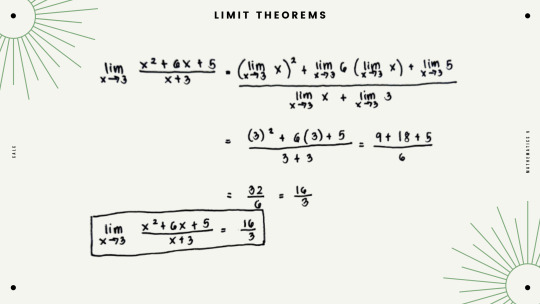
In evaluating the limit of the function above, we used long version where we used theorems 2 (the limit of a constant is itself), 3 (the limit of x as x approaches a is a), 4 (the product of a constant and a function is equal to the product of the limit of the function and the constant), 5 (the limit of the sum of functions is equal to the sum of the limits of each function), and 8 (the limit of an integer power of a function is equal to the power of the limit of the function). The other method of solving this would be inputting the a value to the function = f(a).

Learning guide 3.2.2 (Limit theorems)
In learning guide 3.2.1, the nine limit theorems were introduced. However we cannot directly use these theorems for some cases such as the indeterminate type of 0/0. In this learning guide, we will be solving examples of this indeterminate type of 0/0.

As we can see, when 7 was substituted as x, the limit would be 0/0. For this case, we can factor out the numerator to cancel the denominator which leads us to x^2-1. From there, we can now use the limit theorems in Learning guide 3.2.1 to evaluate the limit.
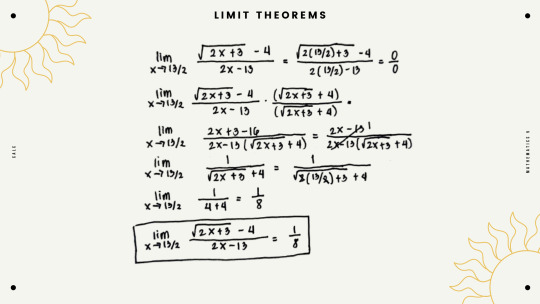
In this example, we have a radical in the numerator that is why we need to rationalize the numerator by multiplying the conjugate. After multiplying we can see that the term 2x-13 (present in both the numerator and denominator) can be cancelled, which will equal to 1. From there, we can use the limit theorems to evaluate the limit.

Reflection (Week 1)

I have learned a lot from my habits during the first quarter and, I have identified the areas in which I can improve more. As we start a new quarter, I vow to improve as a student. I will apply what I think would be best for me in studying. When I browsed the learning guides for this week, at first, I was overwhelmed because I thought the topics for this quarter are much complicated than before. However, as I read and study the material, I gained confidence in solving items related to the topic. Although I don’t know yet what I got in the quiz, I am confident that I have fully understood the lesson. I will maintain my good habits during the first week.
I know that I am off to a good start this quarter.
-m.y.
0 notes
Photo

REFLECTION
Learning guide 2.4 (Introduction to Limits)
Introduction to Limits is one of the most important topics to understand in studying calculus since it is a recurring concept. I was intimidated at first because although I have already heard the term “Limits”, it was a totally new concept to me.
When I scanned through the learning guide, I was a bit frustrated because of the graphs and equations. However, when I actually read it thoroughly, I realized that it was an easy topic to understand. I also watched YouTube videos about Limits to reinforce what I have read.
I think I have maintained being timely for this week. Timeliness is really my strength for the first quarter and I will do my best to keep that up for the next quarters. Overall, I have enjoyed Math 5 this quarter. Although we have a heavy workload, I can say that writing blog entries for this subject is somehow helpful and enjoyable.
0 notes
Photo

INTRODUCTION TO LIMITS
Learning guide 2.4
hi! We are now going to discuss Limits! This concept is really important in the study of calculus that is why we need to study this.
Learning guide 2.4.1
1. Find the limit of 𝑓(𝑥) as x gets near -1. Refer to the graph below. State the left and right-hand limits as x gets near -1 then evaluate 𝑓(−1) .

Based on the graph, as x approaches -1, the value of y approaches 3. This is true for both sides of the function.
2. Determine the limit of 𝑔(𝑥)as x gets near 1. Refer to the graph below. State the left and right-hand limits. Find 𝑔(1).

Here, when the value of x is 1, the function is undefined as indicated by the open circle. The limit of g(x) is 6 because as x approaches 1, the value of the function approaches 6. This is the same for the both sides of the function.
3. Refer to the graph below. Find the limit of ℎ(𝑥)as x approaches -5.
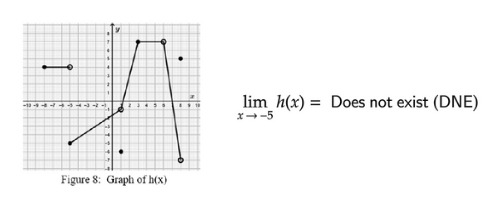
The limit of h(x) as x approaches -5 does not exist. This is because the limit of the left-hand side is not the same with the limit of the right-hand side. The limits of the left-hand and right-hand sides are 4 and -5 respectively.
———————————————————————————————————————————————-
Learning guide 2.4.2
Evaluate the following limits by making two tables of values similar
to Tables 1 and 2.

Since the function would be undefined if the value of x is 0, the reciprocal of the function was used. By plugging-in x values from the left-hand and right-hand sides, we can solve for the value of the function at each x-value. Based on the table, both sides of the function approach 0.25 or 1/4, so the limit of the function is 1/4.

This function can be simplified so that the (x+5) will be cancelled. Plugging-in x values from both sides of the function will give us the value of the function at each x-value. Based on the table as well, both sides of the function approach -3 as x approaches -5. Thus, the limit of the function is -3.
———————————————————————————————————————————————-
That’s it for the introduction of limits! This will serve as our preparation for the more complex topics in differential calculus. I hope you have learned more about limits in this post. See you in the next blog!
-m.y.

meme from https://www.reddit.com/r/ENFP/comments/9ejphi/the_limit_does_not_exist/?utm_source=share&utm_medium=web2x&context=3
0 notes